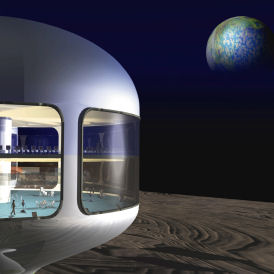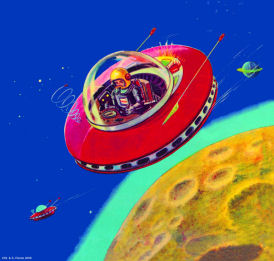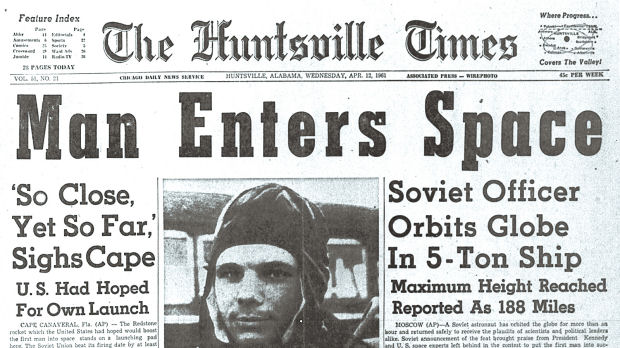Space travel: what next for the final frontier?
Space hotels, bases on the moon and orbiting Venus: half a century after Yuri Gagarin became the first man in space, writer Nick Spall looks at what to expect in the next fifty years.

On April 12 1961 Gagarin became the first human being to be blasted into space, completing a single orbit of the Earth. He collected a string of “extreme” records by travelling at almost 18,000 mph (Mach 25), reaching an altitude of 188 miles and experiencing prolonged weightlessness for over 90 minutes.
The venture was very risky at that time – no-one really knew what lengthy zero-gravity would do to a human body, whether it was possible to swallow, to breathe properly or even maintain a proper inner-ear balance in space.
The flight was also technically hazardous. His R7-based launcher was still an unreliable rocket at that time, despite the best efforts of Russia’s brilliant “Chief Designer” Sergei Korolev. On re-entry Gagarin almost became unconscious when his Vostok capsule failed to separate from its instrument module and spun wildly around its axis. Spaceflight is more routine now of course, but since 1961 eighteen astronauts have been killed in spaceflight accidents.
So what has been accomplished in human spaceflight since 1961 and what could be achieved in the next 50 years?

Gagarin’s legacy
Coming only 58 years after the Wright brothers began powered flight and 18 years after the first V2 rockets reached sub-orbit, following Gagarin’s Vostok flight the progress of human spaceflight seemed to be unstoppable.
Inspired by the Cold War “space-race”, within eight years Neil Armstrong would be the first of 12 men to step out onto the surface of the Moon. Six years after that in 1975 Russians and Americans joined up their Apollo and Soyuz spacecraft in orbit, cementing a future of international cooperation in space. A further five years on and humans were living in orbit for many months at a time. Today wealthy tourists with £35 million in their pockets can visit the International Space Station, 220 miles above the Earth for a week’s stay.
Despite these achievements, the hoped for lunar base that Werner Von Braun dreamed of in the 1960s has not become a reality. President Obama has now directed NASA to focus on incremental cost-cutting privately developed rocketry for the time being and the US intends to leave the Moon and Mars alone until the longer-term.

The next 50 years
But what will occur in human spaceflight development during the next 50 years?
The costs and technical challenges are formidable and world recessions and spending cuts will bite deep into future budgets for government-led space exploration. However, what seems clear is that deep-space exploration to the Moon, asteroids, Mars and beyond will be the province of international cooperation, with the USA , Europe, Russia, Japan and soon China and India teaming-up together for common spaceflight goals.
This joint approach will be fuelled by commercial-sector tourism and economic exploitation interests.
The following key developments are technically possible and, given the political will, are likely at some point in the next half-century; so here are some speculative and “reasonable” projected dates for future human spaceflight milestones:

– Regular tourist flights to sub-orbit space (62 miles/100 km altitude) by Virgin Galactic and others – 2012.
– Privately developed crewed spacecraft to Earth orbit – 2014
– China and India access new mini-space stations – 2015
– Private space hotels in orbit – 2016.
– The ISS continues into its third decade of operation, with commercial companies and space tourist modules added and a 40 year lifetime agreed – 2020
– Private tourist spaceflights around the Moon – 2021
– Visits to Earth’s Lagrange points, 1.5 million miles away – 2024
– Deep-space flights of 3 months plus duration and first landing on an asteroid – 2025
– An international expedition to Mars orbit and landings on the moons Phobos and Deimos – 2028
– First human landing on Mars – 2030
– A permanent international lunar research base – 2034
– Tourist hotel on the Moon – 2040
– Science station established on Mars – 2045
– Deep space human “grand-tour” of the solar system, including Venus orbit, landings on Mercury, asteroid Ceres, Jupiter’s moons Europa and Gannymede and Saturn’s moon Titan – 2055
– Human landing on Halley’s Comet (during its return’s “quiet-period”) – 2061.
Many consider that Gagarin’s achievement and legacy is akin to the first visits to the New World, late in the 15th century. If the public will is there, human spaceflight is likely to have no boundaries beyond its future “100 year anniversary” of this, the first ever human flight to orbit.
Nick Spall is a space writer who has written for Spaceflight and Aerospace International as well as The Times and The Guardian and the influential Space Policy Journal. He has also given public lectures on human spaceflight.
